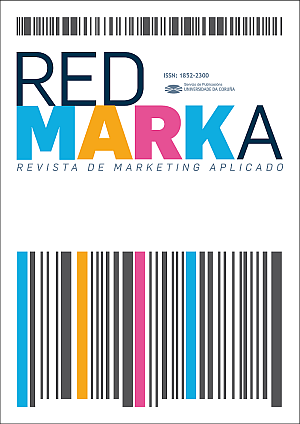Media influence in the perception of image Analysis over the appointment of the Tower of Hercules as word heritage, its reflect in the general press and repercussion in the tourism promotion of A Coruña
Main Article Content
Abstract
The present study tries to analyze the influence that there exercise the media of social communication in the formation of the image of a tourist destination. Concretely, one presents the case of A Coruña and his recent appointment on the part of the UNESCO as Heritage of the Humanity to one of the most emblematic monuments of the city, The Hercules' Tower. The work will try to know the repercussion and social influence of the mass media on the perception of the image of The Hercules' Tower before and after his appointment. To the being a project of such an importance the efforts will be fixed in knowing the influence of the press of general information and daily diffusion where major presence acquires you notify her and to quarrel if some relation exists between the generated news and the number of visitors to the mentioned monument.
Keywords:
Downloads
Article Details
References
Andreu, L., Bigné, J.E. y Cooper, C. (2000): “Projected and Perceived Image of Spain as a Tourist Destination for British Travellers”. Journal of Travel & Tourism Marketing, Vol. 9 (4), pp. 47-67.
Assael, H. (1984): Consumer Behavior and Marketing Action. Boston: Kent Publishing.
Baloglu, S. y McCleary, K.W. (1999a). A Model of Destination Image Formation. Annals of Tourism Research. Vol. 26, Nº 4, pp. 868-897.
Beerli, A. (1998). Imagen Exterior. En Gran Canaria Siglo XXI. Diagnóstico de Situación. Tomo II. Excmo. Cabildo Insular de Gran Canaria. Universidad de Las Palmas de Gran Canaria, pp. 1956-1980.
Crompton, J. Y Ankomah, P.K. (1993). Choice set propositions in destination decisions. Annals of Tourism Research, 20 (3) pp. 461-476.
Crompton, J.L.; FAkeye, P.C. y Lue, CH. (1992). Positioning: The Example of The Lower Rio Grande Valley in the Winter Long Stay Destination Market. Journal of Travel Research. Fall, pp. 20-26.
Chon, K.S. (1990). The Role of Destination Image in Tourism: A Review and Discussion. The Tourist Review. Vol. 45, nº 2, pp. 2-9.
Court, B. y Lupton, R.A. (1997): “Customer Portfolio Development: Modeling Destination Adopters, Inactives, and Rejecters”. Journal of Travel Research, Vol. 36(1), pp. 35-43.
Fakeye, P.C. y Crompton, J.L. (1991). Image Differences between Prospective, First-Time, and Repeat Visitors to the Lower Rio Grande Valley. Journal of Travel Research.
Gallarza, M.G., Gil, I. y Calderón, H. (2002). Imagen de Destino: hacia un marco conceptual. Annals of Tourism Research. 29 (1), pp. 56-78.
Gartner, W. C. (1993). Image Formation Process. En Communication and Channel Systems in Tourism Marketing. Uysal y Fesenmaier eds. Haworth Press. New York, pp. 191-215.
Gunn, C. (1972). Vacationscape: Designing Tourist Regions. Austin: Bureau of Bussiness Research, University of Texas.
Gunn, C. (1988). Vacationscape: Designing Tourist Regions. Van Nostrand Reinhold. New York. (2ª ed.).
Jenkins, C. (1978). Family Decision Making. Annals of Tourism Research. Vol. 9, Nº 2, pp. 229-249.
Molina, A. (2002). Análisis de Imagen y Utilidad Generada por los Folletos de Información Turística: Evaluación e Influencia sobre la Elección de un Destino Turístico. Tesis Doctoral. Universidad de Castilla–La Mancha. España.
Pearce, P. L. (1982). Perceived Changes in Holiday Destinations. Annals of Tourism Research. Vol. 9, pp. 145-164.
Phelps, A. (1986). Holiday Destination Image -the Problem of Assessment. An Example Developed in Menorca. Tourism Management. September, pp. 168-180.
Reynolds, W.H. (1965): “The Role of the Consumer in Image Building”. California Management Review, Vol.7, pp. 69-76.
Riel, C.B. (1997). Comunicación Corporativa. Prentice Hall. Madrid.
Stabler, M.J. (1995). The Image of Destination Regions: Theoretical and Empirical Aspects. En Marketing in Tourism Industry: The Promotion of Destination Regions. Goodall y Ashworth eds. London, pp. 133-159.
Stern, E. y Krakover, S. (1993). The Formation of a Composite Urban Image. Geographical Analysis. Vol. 25, Nº 2, pp. 130-146.
Yoon, S.J., y Kim, J.H. (2000): “An Empirical Validation of a Loyalty Model Based on Expectation Disconfirmation”. Journal of Consumer Marketing, Vol.17 (2), pp. 120-136.
WEBGRAFÍA
EL CORREO GALLEGO, Dirección URL: https://www.elcorreogallego.es [Consulta: 2011]
EL MUNDO, Dirección URL: https://www.elmundo.es [Consulta: 2011]
EL PAÍS, Dirección URL: https://www.elpais.es [Consulta: 2011]
GALINOR, Dirección URL: https://www.galinor.es [Consulta: 2011]
GALICIA VIRTURAL, Dirección URL: https://www.galiciavirtual.net [Consulta: 2011]
IET, Dirección URL: https://www.iet.es [Consulta: 2011]
IGE, Dirección URL: https://www.ige.es [Consulta: 2011]
INE, Dirección URL: https://www.ine.es [Consulta: 2011]
LA RAZÓN, Dirección URL: https://www.larazón.es [Consulta: 2011]
LA TORRE DE HÉRCULES, Dirección URL: https://www.latorredehercules.net [Consulta: 2011]
LA VOZ DE GALICIA, Dirección URL: https://www.lavozdegalicia.es [Consulta: 2011]
NEW YORK TIMES, Dirección URL: https://www.nytimes.com [Consulta: 2011]
PUBLICO, Dirección URL: https://www.publico.es [Consulta: 2011]
TURGALICIA Dirección URL: https://www.turgalicia.es [Consulta: 2011]
THE TIMES, Dirección URL: https://www.thetimes.co.uk [Consulta: 2011]
TORRE DE HÉRCULES, Dirección URL: https://www.torredeherculescoruna.com [Consulta: 2011]
XORNAL, Dirección URL: https://www.xornal.es [Consulta: 2011]
XUNTA, Dirección URL: https://www.xunta.es [Consulta: 2011]






